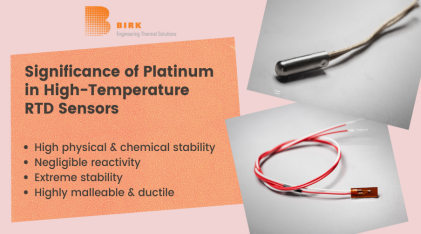Resistance temperature detectors (RTDs) are one of the more popular temperature sensors, and are also known as resistance thermometers. These temperature sensors work on the principle of resistance-temperature interrelation. The RTDs feature a pure metal wire, which may be copper, nickel, or platinum, wrapped around a ceramic or glass core. However, platinum is the preferred material for the temperature probes and surface mount RTD sensors. It is essential to understand what makes platinum a popular choice in these sensors. This post discusses the factors that contribute to the construction and performance of temperature sensor probes and surface mount RTDs.
Platinum: A Unique Choice for Industrial Applications
Platinum (Pt) is a highly demanded metal in industries such as jewelry making, electrical, and medical. The silver-like lustrous metal is a superior material and is known for its negligible reactivity with surrounding factors. The following physical and chemical properties of platinum play an essential role in its suitability for the construction of RTDs.
- Melting point: approximately 1770°C or 3220°F
- High malleability
- High corrosion resistance
- Highly ductility
- Stable electric properties
- High wear and tarnish resistance
- Chemical stability
Significance of Platinum in High-Temperature RTD Sensors
Platinum is an important component of high-temperature RTD sensors for the following reasons:
- Platinum offers high physical and chemical stability. RTDs are constructed compactly and well suited for high-temperature applications. Both temperature probes and surface mount RTD sensors are exposed to high temperatures and harsh environments during industrial operations. Since the temperature tolerance of platinum is extremely high, it becomes a potential choice for pure metal wires in high-temperature RTD sensors.
- RTDs are often exposed to chemicals, temperature fluctuations, external loads, mechanical vibrations, and shocks. However, platinum offers negligible reactivity and extreme stability against certain conditions.
- Platinum is highly malleable and ductile; thus, it can easily be turned into wires, threads, and films while retaining its dimensional stability. The surface mount temperature sensors are made from thin films of platinum. Also, the RTD temperature probe requires flexibility in the temperature-sensing elements, which can be achieved by using platinum.
- Platinum ensures high stability and extremely low fluctuations in temperature readings. This property of platinum contributes to the precision and stability of temperature measurement in the RTDs.
All the factors mentioned throughout this blog contribute to the significance of platinum in RTDs.
These benefits prove vital in the construction of temperature probes and surface mount RTDs. Birk Manufacturing, Inc. is a prominent RTD sensor manufacturer and an ITAR, ISO 13485:2016, AS9001 Rev D, and CSA & UL certified organization. The quality and performance of its temperature sensors are relied on throughout multiple industries, including no-fail applications. Along with temperature probes and surface mount RTD sensors, the company offer high-quality thermal solutions and flexible heating elements used in various mission-critical applications.
